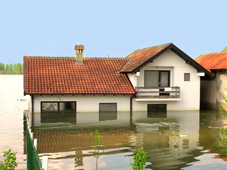 Homeowners insurance rarely includes coverage for damages caused by flooding. Flood insurance is usually a separate policy that is strongly recommended for properties with medium to high flood risk assessment. Depending on the level of flood risk assigned to a property, mortgage financing agencies may require a borrower to carry flood insurance. It's possible to lower flood insurance costs by making changes to your property that reduce potential flood damage.
Homeowners insurance rarely includes coverage for damages caused by flooding. Flood insurance is usually a separate policy that is strongly recommended for properties with medium to high flood risk assessment. Depending on the level of flood risk assigned to a property, mortgage financing agencies may require a borrower to carry flood insurance. It's possible to lower flood insurance costs by making changes to your property that reduce potential flood damage.
What's Included in a Flood Risk Assessment
Flood insurance costs aren't calculated solely by a structure's location within a flood zone. Flooding history, structural design and building materials also factor into the calculation.
Many flood maps aren't specific enough and may need updating. If you think the flood designation for your property is too high, you can apply to change it by filling out a Letter of Map Change.
Community Strategies
There's little an individual can do to eliminate floods, but over time flooding patterns do change as a result of changes in the local environment. Things like deforestation or ground leveling can alter floodwater flow patterns. The National Flood Insurance Program works with local communities to install community-wide prevention measures with insurance cost reductions as incentives.
Individual Property Owners
Selecting higher deductibles is one obvious way to cut costs, but there are some other options that may fit your situation. If you haven't already bought property, use flood insurance maps to locate areas in your region where flooding is less frequent and less severe. But remember flooding can occur anywhere, even in low risk zones. In fact, 25 percent of paid claims are for damages that occurred outside high risk areas.
Once you have a piece of property, opportunities exist for reducing potential damage at the site and building levels. When you're building or rebuilding a structure, look for flood resistant materials and design features that might apply to your flood hazard situation. Using historical flood information, incorporate design features such as raising the structure above the height of the highest historic flood levels. Consider having water vents added to the home. If basements are part of the structure, use water-resistant materials and treatments, and raise mechanical and electrical systems above the height of the highest historic flood levels.
There are options for already existing structures. Install sump pumps, sewer backup valves and water vents. Again, consider moving or raising mechanical and electrical systems if it's possible, and apply water-proofing treatments to basement surfaces.
In 2007, FEMA put out these five suggestions to lower costs:
- Raise the structure three feet above Base Flood Elevation or BFE.
- Raise the utilities and related machinery three feet above BFE. Use an attic or raised platform.
- Eliminate basements and crawlspaces. Backfill crawlspaces with pea gravel.
- Install flood openings or vents. The number and size depend on the flood zone.
- Relocation. Move your home to natural grade level, three feet above BFE.
Selecting which improvements are most practical for your situation largely depend on the area's flooding history. For more information, check with your independent insurance agent for advice before you get started.
Protect your home and family. Call Reliable Insurance Managers at (713) 227-7283 for more information on Katy flood insurance.